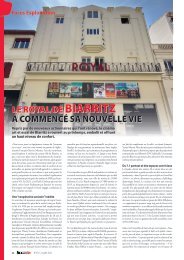You also want an ePaper? Increase the reach of your titles
YUMPU automatically turns print PDFs into web optimized ePapers that Google loves.
J<br />
I<br />
I<br />
'li<br />
EACH<br />
system of wiring and the equipment supplied<br />
by it represents a wide variety of applications,<br />
maintenance methods, and fluctuating load<br />
demands. The theatre maintenance man should<br />
know intiimately these various factors and conditions,<br />
and keep the electrical system in good<br />
operating condition for both normal and emergency<br />
requirements. A regular, detailed survey of the<br />
system is essential to achieving this result, and<br />
L. E. Pope offers such a survey in this installment<br />
of the Manual of Preventive Maintenance. L £. Pope<br />
CHECKING THI<br />
l-;-i«w>KvvK-X"aw<br />
THOROUGH SURVEY OF ALL<br />
PART TAR I AIA yiy<br />
BRANCHES IS IMPORTANT<br />
by L. E. POPE<br />
Preventive Maintenance of the Electrical System<br />
marked or labeled to permit quick and correct replacement': f-<br />
— ^'<br />
IK (Oils<br />
ai<br />
Last month the author described the purpose and need for<br />
a proper maintenance program for the theatre electrical system,<br />
and in section No. 9 pointed out that if a survey is carefully<br />
conducted and recorded periodically , the complete system<br />
is always clearly identified as to connected devices, circuits,<br />
feeders and departmental or building load conditions. Questions<br />
in the detailed survey he suggests follow.<br />
10. SUGGESTED THEATRE SURVEY GUIDE,<br />
GENERAL WIRING CONDITIONS<br />
A. Adequacy.How old is the wiring? Has the load been<br />
increased? Has the service been enlarged? The<br />
feeders? Have alterations been made permanent?<br />
Or temporary? Is system overloaded? Are future<br />
additions planned?<br />
Have future loads been provided<br />
for?<br />
Is a plan of present wiring available?<br />
B. Insulation. Has an insulation resistance test been made in<br />
accordance with Section 513 of the N. E. C?<br />
Have any<br />
parts of the plant been damaged by fire? Which runs<br />
are subjected to: Seepage? Condensation traps?<br />
Oil accumulation? Excessive temperatures?<br />
Natural deterioration?<br />
C. Heating. Are lugs or terminals electrically secured?<br />
Are all buses and tap-off contacts: Clean? Securely<br />
clamped or bolted?<br />
In contact alignment?<br />
Are AC feeders free of inductive heating: In conduits?<br />
In metal ducts? In bus clamps? Are heavy resistors<br />
properly ventilated and isolated from massed conductors?<br />
D. Safety. Are safeguards provided for protection against shocks<br />
from; Dangerous voltages? Live parts? Near<br />
grounded surfaces, machinery or piping systems? .: Are<br />
conduits, enclosures, control devices or supports guarded or located<br />
to minimize: Stumbling? Dangerous tripout<br />
blows? Crushed hands or fingers? Are employes<br />
protected against: Accidental starting or over-running of<br />
machinery?<br />
Opening switches under load?<br />
Fu.se blowout flashes? Explosions?<br />
E. Overload Protection. Are all feeders and circuits protected<br />
with automatic overload protective devices to correspond with<br />
N.E.C. capacity ratings? Have they been altered,<br />
bridged or otherwise tampered with?<br />
Are they plainly<br />
F. Makeshift Wiring. Are temporary wires to be replaced anc<br />
made permanent? Or removed? Have alterations<br />
been properly designed to suit the main layout?<br />
G. Dampness. Does wiring in damp locations exclude moisture?<br />
Are conduits suitably drained? Are couplings<br />
and outlet connections leaded? Are devices de-i<br />
signed for damp locations?<br />
Are gaskets intact?<br />
H. Corrosive Acids and Gases. Are copper surfaces coated tci<br />
prevent corrosion?<br />
Have enclosures been designed to<br />
exclude injurious effects?<br />
I. Hazardous Locations. Are certain areas hazardous?<br />
Dust? Vapors? Lints? Liquids?!<br />
Can electrical equipment be isolated from such exposures?<br />
Are present devices designed for maximunii<br />
protection in the specific location?<br />
J. Heat-Fire Resistance. Aie high-temperature-area conductors,<br />
holding up?<br />
Will maintenance economies result from<br />
asbestos insulation?<br />
;<br />
K. Mechanical Injury. Are there loosened or damaged conduits,<br />
fittings and equipment? Can maintenance and inter-:<br />
ruptions be avoided by: Relocating? Strapping?!<br />
Tightening? Recessing? Guarding?<br />
j<br />
L. Grounding. Are system, equipment and conduit grounds of<br />
Code capacity? Suitably protected against injury?:<br />
Are resistance values at artificial grounds sufficiently<br />
low? Is static electricity generated? Correctly<br />
grounded?<br />
Are lighting arresters intact?<br />
Are portable devices polarized and wired to ground plugs?<br />
11. SERVICE AND DISTRIBUTION WIRING<br />
I<br />
A. Substations, is present service primary or secondary voltage?'<br />
Will private transformer station reduce power bills?<br />
Are isolated buildings more efficiently supplied by<br />
outlying transformer stations? Does present service<br />
provide lowpst power cost?<br />
Continuous supply?<br />
Adequate capacity?<br />
Minimum liazard?<br />
B. Conversion. If DC. will AC changeover effect economics?<br />
If 220 volt AC, will higher voltage changeover relieve<br />
present feeder overload and permit expansion?<br />
j<br />
:)iio«J Co<br />
!::p'er(<br />
k flei<br />
n<br />
-: :c: D<br />
It<br />
'Sfjfooi<br />
24 The MODERN THEATRE SECTION

















